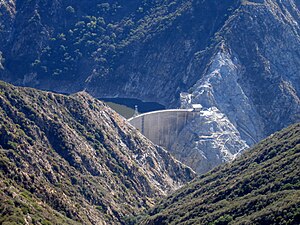Pacoima Dam
| Pacoima Dam | |
|---|---|
 The Pacoima Dam, viewed from Contract Point. | |
| Country | United States |
| Location | Los Angeles County, California |
| Coordinates | 34°20′05″N 118°23′47″W / 34.33472°N 118.39639°W |
| Status | In use |
| Construction began | 1925 |
| Opening date | 1928 |
| Owner(s) | Los Angeles County Department of Public Works |
| Dam and spillways | |
| Type of dam | arch |
| Impounds | Pacoima Creek |
| Height | 371 feet (113 m) |
| Length | 640 feet (200 m) |
| Spillways | 1 |
| Spillway type | Service, concrete tunnel |
| Spillway capacity | 24,700 cubic feet per second (700 m3/s) |
| Reservoir | |
| Creates | Pacoima Reservoir |
| Total capacity | 3,777 acre⋅ft (4,659,000 m3) |
| Catchment area | 27.8 square miles (72 km2) |
| Surface area | 68 acres (28 ha) |
Pacoima Dam is a concrete arch dam on Pacoima Creek in the San Gabriel Mountains, in Los Angeles County, California. The reservoir it creates, Pacoima Reservoir, has a capacity of 3,777 acre⋅ft (4,659,000 m3)[1]
Built by the Los Angeles County Flood Control District, which became part of the Department of Public Works, it was completed in 1928. At the time, the 371 foot (113m) high dam was the tallest arch dam in the U.S.[1]
The dam is situated approximately 1 mile (1.6 km) northeast of Sylmar, above the San Fernando Valley.[1] As a flood control structure, district routinely compensates for hydraulic deficiencies in downstream areas by restraining flows of stormwater released from the dam.[2]
Instrumentation
[edit]As construction of Pacoima Dam began, the County of Los Angeles hired Roy W. Carlson[3] as their concrete and soil testing engineer. He developed the world's first strain meter which could be embedded in concrete. He also developed an adiabatic calorimeter and electrical-resistance thermometers to find why the temperature of concrete increased during curing and how best to avoid cracking caused by these stresses.[4]
Earthquake monitoring
[edit]The Pacoima Dam withstood, but was damaged by the very strong (>1 g) ground movement which occurred during both the 1971 San Fernando and 1994 Northridge earthquakes. Because of concerns about the stability of the dam and especially its response to potential future earthquakes, the County of Los Angeles, with the technical support of the USGS, began monitoring the dam using continuous GPS.[1]
See also
[edit]References
[edit]- ^ a b c d Hudnut, Kenneth W. & Behr, Jeffrey A. (1998). "Continuous GPS monitoring of Structural Deformation at Pacoima Dam, California". Seismological Society of America. Retrieved January 23, 2014.
- ^ Sahagún, Louis (March 18, 2023). "Flooding vulnerabilities of L.A. River's Glendale Narrows spark concern amid record rain". Los Angeles Times. Retrieved March 18, 2023.
- ^ Electrical Engineering and Computer Sciences, UC Berkeley "Dr. Roy W. Carlson"
- ^ Rogers, J. David (2012). "DAMS AND DISASTERS: a brief overview of dam building triumphs and tragedies in California's past" (PDF). University of California Davis. Retrieved January 23, 2014.
External links
[edit]- Image of workers at the bottom of a canyon at the Pacoima Dam site working on wood framing and concrete pouring, 1926. Los Angeles Times Photographic Archive (Collection 1429). UCLA Library Special Collections, Charles E. Young Research Library, University of California, Los Angeles.

